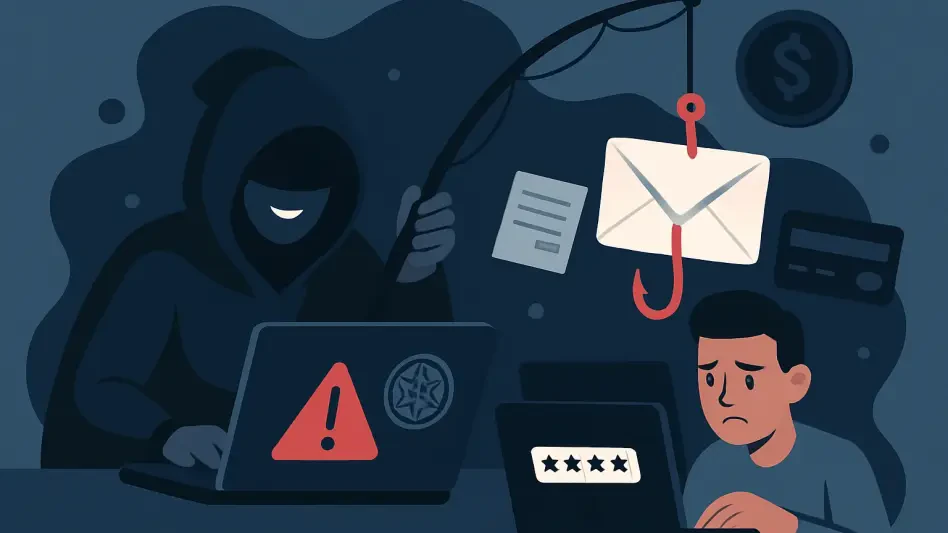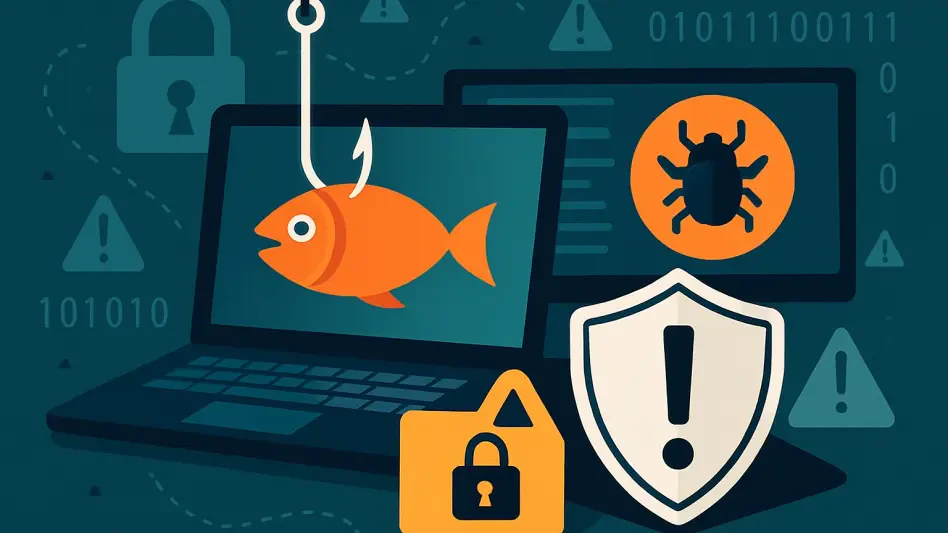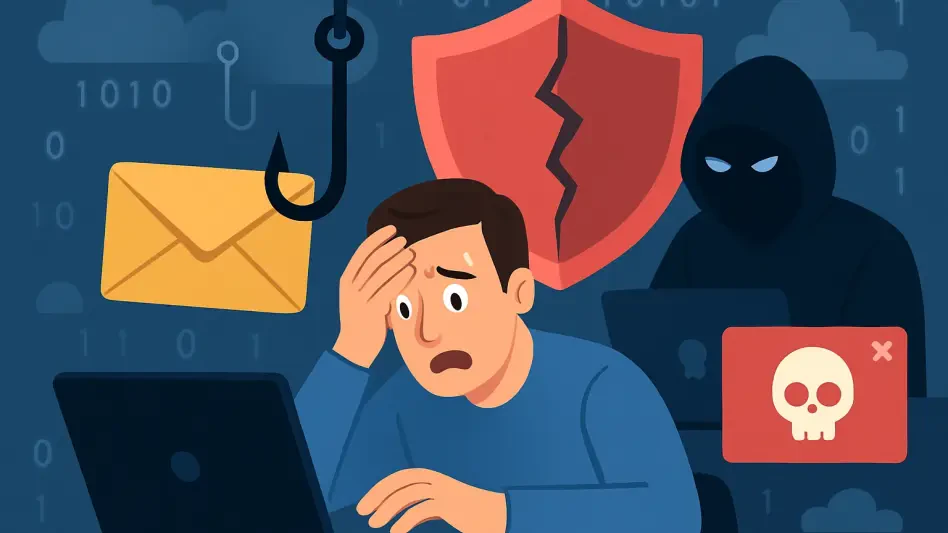In an era where digital connectivity underpins the operations of nearly every industry, a new and insidious phishing campaign known as UpCrypter has emerged as a formidable adversary for enterprises worldwide, targeting sectors from manufacturing to healthcare. This sophisticated attack vector has rapidly gained traction, affecting organizations in technology and retail as well. By deploying remote access tools (RATs) like DCRat, Babylon RAT, and PureHVNC, attackers behind UpCrypter are not merely seeking credentials but aiming for long-term control over compromised systems. The campaign’s ability to blend personalization with advanced evasion tactics marks it as a significant escalation in the phishing threat landscape, posing a dire challenge to cybersecurity defenses. As enterprises grapple with this evolving menace, understanding the mechanisms and implications of such attacks becomes paramount to safeguarding sensitive data and maintaining operational integrity.
Unveiling the Mechanics of a Sophisticated Threat
Dissecting the Multi-Vector Attack Chain
The UpCrypter campaign employs a cunning multi-vector approach that begins with carefully crafted phishing lures designed to maximize victim engagement across diverse industries. These lures often take the form of voicemail-themed emails with subjects like “Missed Phone Call” or purchase order notifications, sometimes incorporating Chinese characters to target specific demographics. Delivered through HTML attachments, these emails contain obfuscated JavaScript that redirects unsuspecting users to spoofed landing pages. What sets these pages apart is their high level of personalization, often featuring the target’s email domain and corporate logos to build trust. Once engaged, victims are prompted to download ZIP archives harboring heavily obscured JavaScript files. These files, in turn, execute PowerShell commands with elevated privileges, paving the way for the deployment of RAT payloads that grant attackers deep access to compromised systems. This intricate chain of deception underscores the campaign’s dangerous potential to bypass conventional security measures.
Evasion Tactics That Challenge Detection Efforts
Beyond its deceptive delivery methods, UpCrypter stands out for its advanced evasion and anti-analysis capabilities, which pose significant hurdles for cybersecurity professionals. The framework actively targets forensic tools, debuggers, and sandbox environments, often triggering system restarts or deleting artifacts when it detects investigative activity. Such measures severely hamper efforts to analyze and mitigate the threat. Additionally, the malware leverages steganography to conceal malicious code within image files, while using plain text for loader data to evade static detection systems. Persistence is further ensured through modifications to the Windows Registry, allowing attackers to maintain long-term access to infected systems. This combination of tactics represents a shift from traditional phishing to a more comprehensive form of network compromise, utilizing weaponized, publicly available tools to achieve its goals. The sophistication of these evasion methods highlights the urgent need for adaptive security strategies to counter such dynamic threats.
Addressing the Global Impact and Mitigation Strategies
Understanding the Scale of the Threat Worldwide
The global reach of the UpCrypter campaign has become a pressing concern for enterprises, as telemetry data reveals a doubling of detections in just a matter of weeks. This rapid proliferation underscores the campaign’s ability to target a wide array of industries, from construction to technology, with devastating precision. The deployment of RAT payloads enables attackers to exert prolonged control over compromised systems, facilitating potential data theft, espionage, or further network exploitation. Cybersecurity experts have emphasized the severity of this threat, noting that the personalized nature of phishing pages enhances their deceptive power, making them difficult to distinguish from legitimate communications. The implications are far-reaching, as affected organizations face not only immediate financial losses but also long-term reputational damage. As attackers continue to refine their methods, the urgency for enterprises to strengthen their defenses against such sophisticated campaigns cannot be overstated.
Implementing Robust Defenses Against Evolving Attacks
To combat the pervasive threat posed by UpCrypter, a multi-layered approach to cybersecurity is essential, combining technical controls with user education. Security teams are encouraged to enforce PowerShell script signing, utilize Constrained Language Mode, and restrict PowerShell execution for standard users to prevent malicious scripts from running. Application allowlisting also serves as a critical barrier, stopping unauthorized executables even if a user downloads a harmful file. Experts suggest monitoring for specific attack patterns, such as the sequence from opening an HTML attachment to subsequent PowerShell usage, as an effective way to detect and halt attacks early. Moreover, limiting PowerShell access for most users can significantly reduce risk, given that few require it for legitimate purposes. Beyond technical measures, educating staff to recognize phishing lures and suspicious attachments remains a cornerstone of defense, as human error often serves as the entry point for such campaigns.
Charting a Path Forward for Enterprise Security
Reflecting on the havoc wreaked by the UpCrypter campaign, it became evident that traditional security approaches fell short against such sophisticated phishing tactics. Enterprises had to confront the reality that attackers adapted faster than many defenses could evolve, exploiting trust through personalized lures and maintaining persistence with advanced RATs. The rapid spread across industries served as a stark reminder of the vulnerabilities inherent in interconnected systems. Moving forward, organizations must prioritize proactive measures, integrating robust email filtering to catch deceptive messages before they reach users. Behavioral analysis tools should be deployed to identify anomalous activities indicative of RAT payloads. Additionally, fostering a culture of cybersecurity awareness through regular training can empower employees to act as the first line of defense. As the threat landscape continues to shift, investing in adaptive technologies and fostering collaboration with industry peers to share threat intelligence will be crucial to staying ahead of evolving phishing campaigns.








